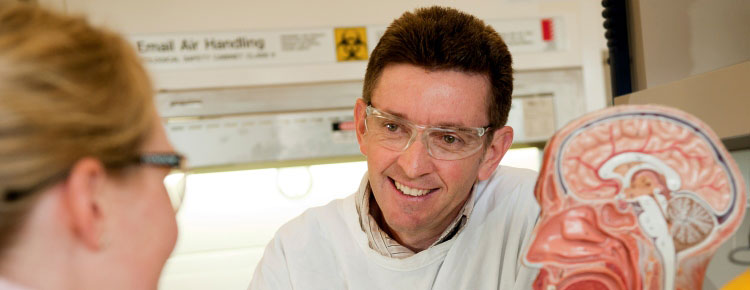Researcher Highlights
Brainstorming the brain
Associate Professor Paul Tooney
Associate Professor Paul Tooney regards his research into schizophrenia as one piece of a complex puzzle that spans many disciplines.

Associate Professor Paul Tooney was undertaking postdoctoral cancer research in the United States when an opportunity to move to Newcastle to apply his cutting-edge skills in cellular and molecular biology to the study of schizophrenia changed the course of his career. Faced with the task of quickly familiarising himself with his new field, Tooney embarked on a self-styled orientation program that both schooled him in the fundamental aspects of the disorder and taught him much about the power of collaboration, a principle that has continued to guide his work.
"Many of my lab skills were transferrable but I really wanted to learn more about schizophrenia," Tooney recalls. "So, I attended clinical research seminars and grand rounds (case-study discussions) with doctors at the local mental health hospital and sat in on a brain anatomy course to enhance my knowledge of neuroscience.
"That allowed me to establish a rapport with many of the wonderful researchers and clinicians here from different disciplines working in the field of psychiatric illness. It became clear to me then that I could either sit in my silo and look exclusively at neurons in the brain or I could get out and see how my research could complement the work of others."
In 1998, Tooney moved to the University of Newcastle as a senior research officer supported by the Schizophrenia Research Institute (SRI), a University partner organisation. He received an academic appointment in 2004 and has since established an extensive collaborative network. Driven by the goal of developing a biological means of diagnosing schizophrenia and identifying new targets for drug discovery, his work draws on the expertise of colleagues in neuroscience, psychiatry, behavioural science, cell biology, genetics, bioinformatics and brain imaging.
Tooney was influential in establishing the Hunter DNA Bank for Schizophrenia and Allied Disorders, and later the nationwide Australian Schizophrenia Research Bank (ASRB) – the genetics arm of which is headquartered in Newcastle. The ASRB is a unique national database of comprehensive medical information collected uniformly from thousands of people, both with schizophrenia and without. Since the bank was launched in 2007, the information collected has been used in more than 65 research projects and over 35 scientific publications.
A strong focus of Tooney's interdisciplinary research is looking for possible subtypes of schizophrenia, using state-of-the-art technologies to study RNA and DNA molecules extracted from brain and peripheral tissue.
"When people are diagnosed with schizophrenia, we put them all into one basket but we know there are differences in the ways that people are affected, so it is likely that we actually have multiple disorders coming under this one diagnosis," Tooney explains. "I am striving to find a genetic basis for these subtypes, cross-referencing my research with patterns that psychologists and psychiatrists see in behaviour and cognition, so that we might be able to classify the disease better.
"Ultimately, if we can develop blood-based diagnostic tests that identify not only who has, or is likely to develop, schizophrenia but also what type of schizophrenia they have, then we might be able to improve our treatments, and in the process understand more about the disorder in general."
Visit the HMRI website
The University of Newcastle acknowledges the traditional custodians of the lands within our footprint areas: Awabakal, Darkinjung, Biripai, Worimi, Wonnarua, and Eora Nations. We also pay respect to the wisdom of our Elders past and present.
